check oil AUDI S3 SEDAN 2015 Owners Manual
[x] Cancel search | Manufacturer: AUDI, Model Year: 2015, Model line: S3 SEDAN, Model: AUDI S3 SEDAN 2015Pages: 282, PDF Size: 71.14 MB
Page 5 of 282
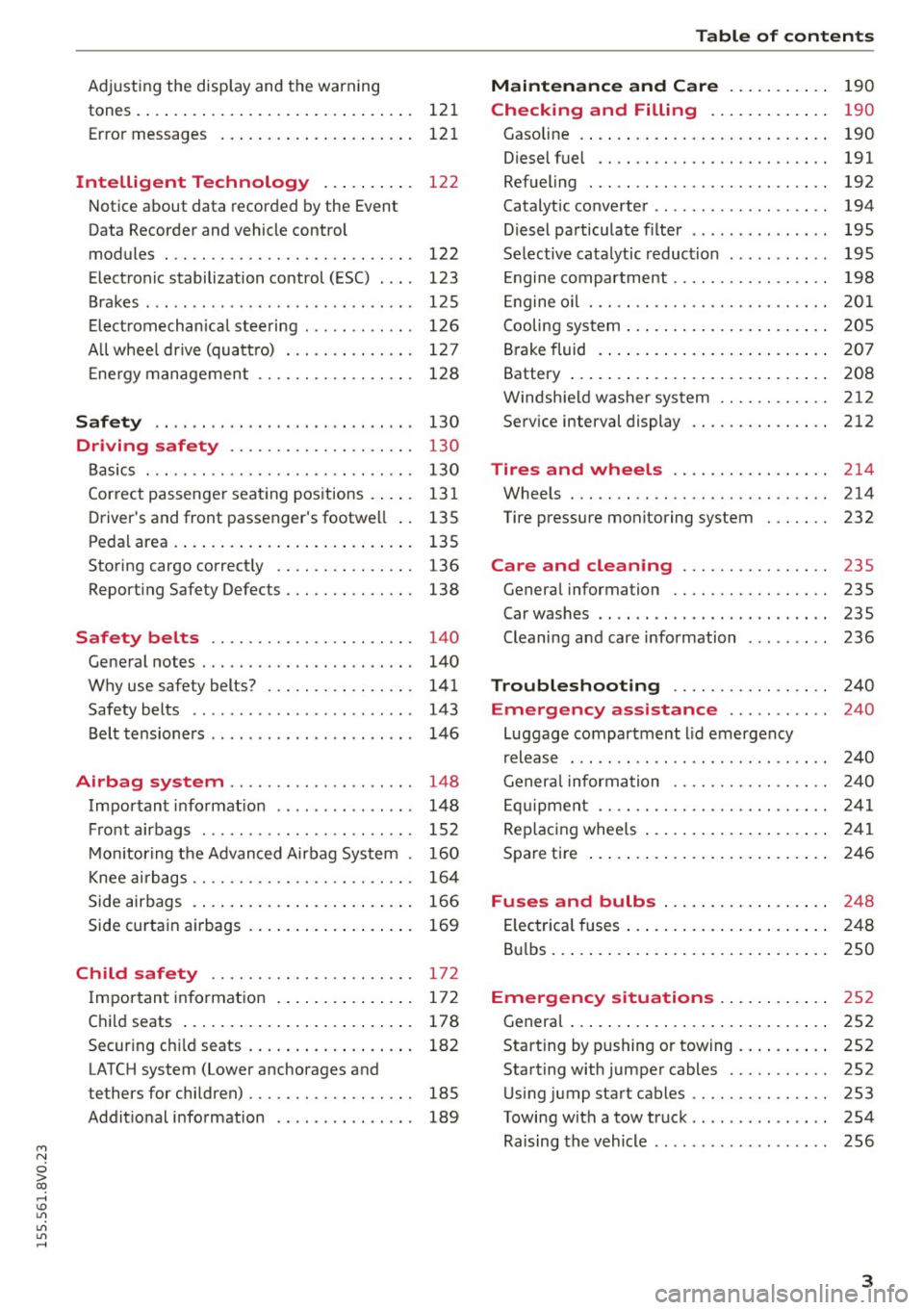
M N
0 > co ,...., \!) ..,.,
..,.,
..,., ,....,
Adjusting the disp lay and the warning
tones .... .. .. .. .... .... ... .. .. .... . 121
Error messages . . . . . . . . . . . . . . . . . . . . . 121
Intelligent Technology . . . . . . . . . . 122
Notice about data recorded by the Event
Data Recorder and vehicle cont rol
modules . . . . . . . . . . . . . . . . . . . . . . . . . . . 122
Electronic stabilization control (ESC) . . . . 123
Brakes . . . . . . . . . . . . . . . . . . . . . . . . . . . . . 125
Electromechanical steering . . . . . . . . . . . . 126
All wheel drive (quatt ro) . . . . . . . . . . . . . . 127
En ergy management 128
Safety . . . . . . . . . . . . . . . . . . . . . . . . . . . . 130
Driving safety . . . . . . . . . . . . . . . . . . . . 130
Basics . . . . . . . . . . . . . . . . . . . . . . . . . . . . . 130
Correct passenger seating positions..... 131
Driver's and front passenger's footwe ll . . 13 5
Pedal area . . . . . . . . . . . . . . . . . . . . . . . . . . 135
Storing cargo correct ly . . . . . . . . . . . . . . . 136
Reporting Safety Defects . . . . . . . . . . . . . . 138
Safety belt s . . . . . . . . . . . . . . . . . . . . . . 140
General notes . . . . . . . . . . . . . . . . . . . . . . . 140
Why use safety belts? . . . . . . . . . . . . . . . . 141
Safety belts . . . . . . . . . . . . . . . . . . . . . . . . 143
Belt tensioners . . . . . . . . . . . . . . . . . . . . . . 146
Airb ag sy stem . . . . . . . . . . . . . . . . . . . . 148
Important information . . . . . . . . . . . . . . . 148
Front airbags . . . . . . . . . . . . . . . . . . . . . . . 152
Monito ring the Advanced Airbag System . 160
Knee airbags . . . . . . . . . . . . . . . . . . . . . . . . 164
Side airbags . . . . . . . . . . . . . . . . . . . . . . . . 166
Side curtain airbags . . . . . . . . . . . . . . . . . . 169
Child safety . . . . . . . . . . . . . . . . . . . . . . 172
I mportant information . . . . . . . . . . . . . . . 172
Child seats . . . . . . . . . . . . . . . . . . . . . . . . . 178
Securing child seats . . . . . . . . . . . . . . . . . . 182
LATCH system (Lower anchorages and
tethers for children) . . . . . . . . . . . . . . . . . . 185
Additional information . . . . . . . . . . . . . . . 189
Table of contents
Maintenance and Care . . . . . . . . . . .
190
Checking and Filling . . . . . . . . . . . . . 190
Gasoline . . . . . . . . . . . . . . . . . . . . . . . . . . . 190
Diesel f uel . . . . . . . . . . . . . . . . . . . . . . . . . 191
Refueling . . . . . . . . . . . . . . . . . . . . . . . . . . 192
Catalytic co nverter . . . . . . . . . . . . . . . . . . . 194
D ie sel particulate filter . . . . . . . . . . . . . . . 195
Selective catalytic reduction . . . . . . . . . . . 195
En gine compartm ent . . . . . . . . . . . . . . . . . 198
Eng ine oil . . . . . . . . . . . . . . . . . . . . . . . . . . 20 1
Cooling system . . . . . . . . . . . . . . . . . . . . . . 205
Brake fluid . . . . . . . . . . . . . . . . . . . . . . . . . 207
Battery . . . . . . . . . . . . . . . . . . . . . . . . . . . . 208
Windshield washer system . . . . . . . . . . . . 212
Serv ice interval display
212
Tires and wheels . . . . . . . . . . . . . . . . . 214
Wheels . . . . . . . . . . . . . . . . . . . . . . . . . . . . 214
Tire pressure monitoring system . . . . . . . 232
Care and cleaning . . . . . . . . . . . . . . . . 235
General information . . . . . . . . . . . . . . . . . 23S
Car washes . . . . . . . . . . . . . . . . . . . . . . . . . 23S
Cleaning and care information 236
Troubleshooting . . . . . . . . . . . . . . . . . 240
Emergency assistance . . . . . . . . . . . 240
Luggage compartment lid emergency
re lease . . . . . . . . . . . . . . . . . . . . . . . . . . . . 240
General informat ion . . . . . . . . . . . . . . . . . 240
Equipm ent . . . . . . . . . . . . . . . . . . . . . . . . . 241
Replacing wheels . . . . . . . . . . . . . . . . . . . . 241
Spare tire . . . . . . . . . . . . . . . . . . . . . . . . . . 246
Fu se s and bulbs . . . . . . . . . . . . . . . . . . 248
El ectrica l fuses . . . . . . . . . . . . . . . . . . . . . . 24 8
Bulbs. . . . . . . . . . . . . . . . . . . . . . . . . . . . . . 250
Emergency situation s . . . . . . . . . . . . 252
General . . . . . . . . . . . . . . . . . . . . . . . . . . . . 252
Starting by pushing or towing . . . . . . . . . . 252
Starting with jumper cables . . . . . . . . . . . 252
Using jump start cables . . . . . . . . . . . . . . . 253
Towing with a tow truck . . . . . . . . . . . . . . . 254
Raising the vehicle . . . . . . . . . . . . . . . . . . . 256
3
Page 14 of 282
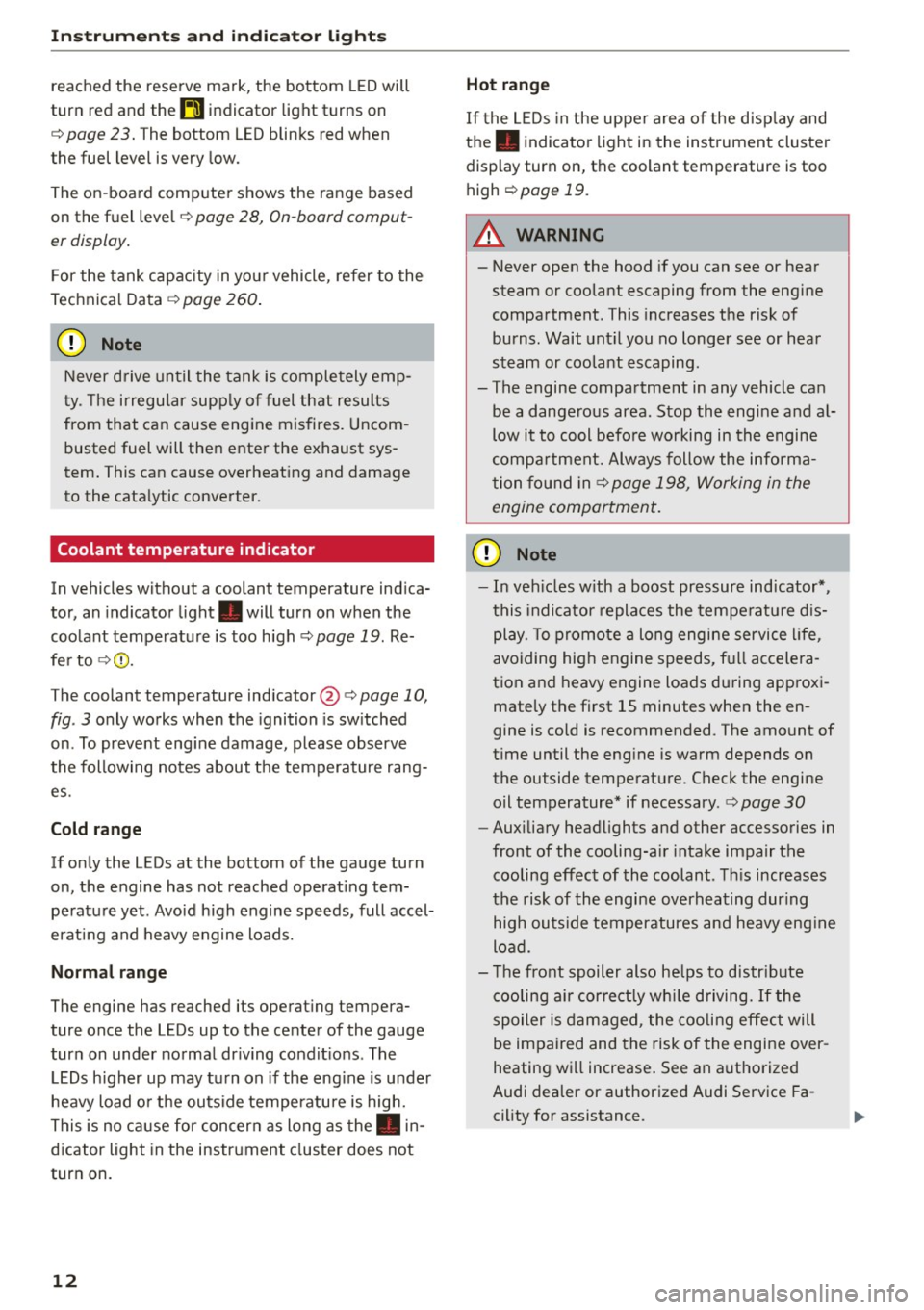
Instruments and indicator lights
reached the reserve mark, the bottom LED will
turn red and the
ljJ indicator light turns on
¢
page 23. The bottom LED blinks red when
the fuel level is very low.
The on-board computer shows the range based
on the fuel level¢
page 28, On-board comput
er display.
For the tank capacity in your vehicle, refer to the
Technical Data
¢ page 260.
(D Note
Never drive until the tank is completely emp
ty. The irregular supply of fuel that results
from that can cause engine misfires. Uncom
busted fuel will then enter the exhaust sys
tem. This can cause overheating and damage
to the catalytic converter.
Coolant temperature indicator
In vehicles without a coolant temperature indica
tor, an indicator light. will turn on when the
coolant temperature is too high ¢
page 19. Re
fer to ¢(1) .
The coolant temperature indicator @c:>
page 10,
fig . 3 only works when the ignition is switched
on . To prevent engine damage, please observe
the following notes about the temperature rang
es.
Cold range
If only the LEDs at the bottom of the gauge turn
on, the engine has not reached operating tem perature yet. Avoid high engine speeds, full accel
erating and heavy engine loads.
Normal range
The engine has reached its operating tempera
ture once the LEDs up to the center of the gauge
turn on under normal driving conditions . The
LEDs higher up may turn on if the engine is under
heavy load or the outside temperature is high.
This is no cause for concern as long as the. in
dicator light in the instrument cluster does not
turn on.
12
Hot range
If the LEDs in the upper area of the display and
the . indicator light in the instrument cluster
display turn on, the coolant temperature is too
high
c:> page 19 .
A WARNING
-Never open the hood if you can see or hear
steam or coolant escaping from the engine
compartment. This increases the risk of
burns. Wait until you no longer see or hear
steam or coolant escaping.
- The engine compartment in any vehicle can
be a dangerous area . Stop the engine and al
low it to cool before working in the engine
compartment. Always follow the informa
tion found in ¢
page 198, Working in the
engine compartment.
(D Note
- In vehicles with a boost pressure indicator* ,
this indicator replaces the temperature dis
play. To promote a long engine service life,
avoiding high engine speeds, full accelera
tion and heavy engine loads during approxi
mately the first 15 minutes when the en
gine is cold is recommended . The amount of
time until the engine is warm depends on
the outside temperature . Check the engine
oil temperature* if necessary .
c:> page 30
-Auxiliary headlights and other accessories in
front of the cooling-air intake impair the
cooling effect of the coolant. This increases
the risk of the engine overheating during
high outside temperatures and heavy engine
load.
- The front spoiler also helps to distribute
cooling air correctly while driving. If the
spoiler is damaged, the cooling effect will
be impaired and the risk of the engine over
heating will increase. See an authorized
Audi dealer or authorized Audi Service Fa
cility for assistance.
Page 21 of 282
![AUDI S3 SEDAN 2015 Owners Manual M N
0 > co ,...., \!) 1.11
1.11
1.11
,....,
If th is message appea rs, press t he b rake pe da l
f ir st and the n re lease the par king brake .
IZ,;11:);MJ~ (USA models) / [i] (Canada AUDI S3 SEDAN 2015 Owners Manual M N
0 > co ,...., \!) 1.11
1.11
1.11
,....,
If th is message appea rs, press t he b rake pe da l
f ir st and the n re lease the par king brake .
IZ,;11:);MJ~ (USA models) / [i] (Canada](/img/6/57653/w960_57653-20.png)
M N
0 > co ,...., \!) 1.1'1
1.1'1
1.1'1
,....,
If th is message appea rs, press t he b rake pe da l
f ir st and the n re lease the par king brake .
IZ,;11:);MJ~ (USA models) / [i] (Canada models)
Caution: Vehicle parked too steep
I f the indicator lig ht blinks and t he messag e ap
pea rs, there is no t enoug h bra kin g power to se
cure the vehicle. The b rakes have ove rhe ate d. T he
ve hicl e c ould r oll aw ay even on a sm all incli ne.
l:(;1;1:t:);MJ~ (USA models ) / [i] (Canada models)
Parking brake is applied
I f th is message appears , press t he brake pedal
f ir st and the n re lease the par king b rake if neces
sa ry .
(D Tips
For addit io nal information o n the park ing
b ra ke, re fe r to ¢
page 78.
_L Cooling system
• Switch off engine and check coolant level!
The coolant leve l is too low or the coolant tem
pe ra tu re is too hig h.
Do not cont inue driving and switc h the engine
off. C hec k the coolant leve l¢
page 205.
- If the coolant leve l is too low, add coolant
¢ page 206 . Only cont inue driv ing once t he in
dicator light turns off.
- If the coolant is at the correct level , the prob
l em may be ca used by a ma lf u nction in the radi
ator fan. Do not cont inue driv ing. See an au
t h orized Aud i dea le r or authorized Audi Service
Fac ility for assistance .
• Coolant temperature too high! Let engine
run with vehicle stationary
L e t th e en gine cool by r unnin g it in idle for a few
minutes .
A WARNING
-Never open t he hoo d if you ca n see o r hear
steam o r co olant escap ing from the engine
compartment. T his i ncreases the ris k of
bur ns. Wai t until yo u no lo nger see o r hear
steam o r co olan t escap ing .
Instruments and indicator lights
-The engine compa rtment in any vehicle ca n
be a dange ro us area . Sto p the engine and a l
low it t o cool befo re working in the engine
compa rtment. Always follow the informa
tion fo u nd in ¢
page 198, Working in the
e ngine compartment .
(D Note
Do not cont inue dr iv ing if the . indicato r
li g ht tur ns on -this inc reases the r isk o f en
g in e damage.
"1::::7: Engine oil pressure
• Switch off engine! Oil pres sure too low
St op t he engine and do not cont inue drivi ng .
Ch eck the eng ine oi l level
¢ page 203.
- If the engine o il level is too low, add eng ine oi l
¢ page 201 . Only continue dr iving once the in
dicator light turns off.
- If the engine o il level is co rrect and the indica
to r li ght still turns on, turn t he e ngine off and
do not cont inue drivi ng. See an authorized Aud i
dea le r or a uth o rized Aud i Serv ice Facility fo r as
sis tance .
(D Tips
The oil pressu re war ning is not an oi l level i n
dicator . Always chec k the o il l ev el re gular ly .
0 Alternator/battery
• Alternator fault : battery is not being charg
ed
T he re is a malfunction in the al ternator or the ve
hicle e lectr ica l system .
Drive to an authorized A udi dealer or autho rized
Audi Serv ice Facility immed iately. Because t he ve
hicle battery is d ra ining, turn off all unnecessary
elect rical e quipment suc h as th e MMI. Seek pro
fe ssional ass istance if t he battery charge lev el is
too low.
(•) Low battery charge: Battery will be charged
while driving
The starting ab ility may be impaired.
19
Page 25 of 282
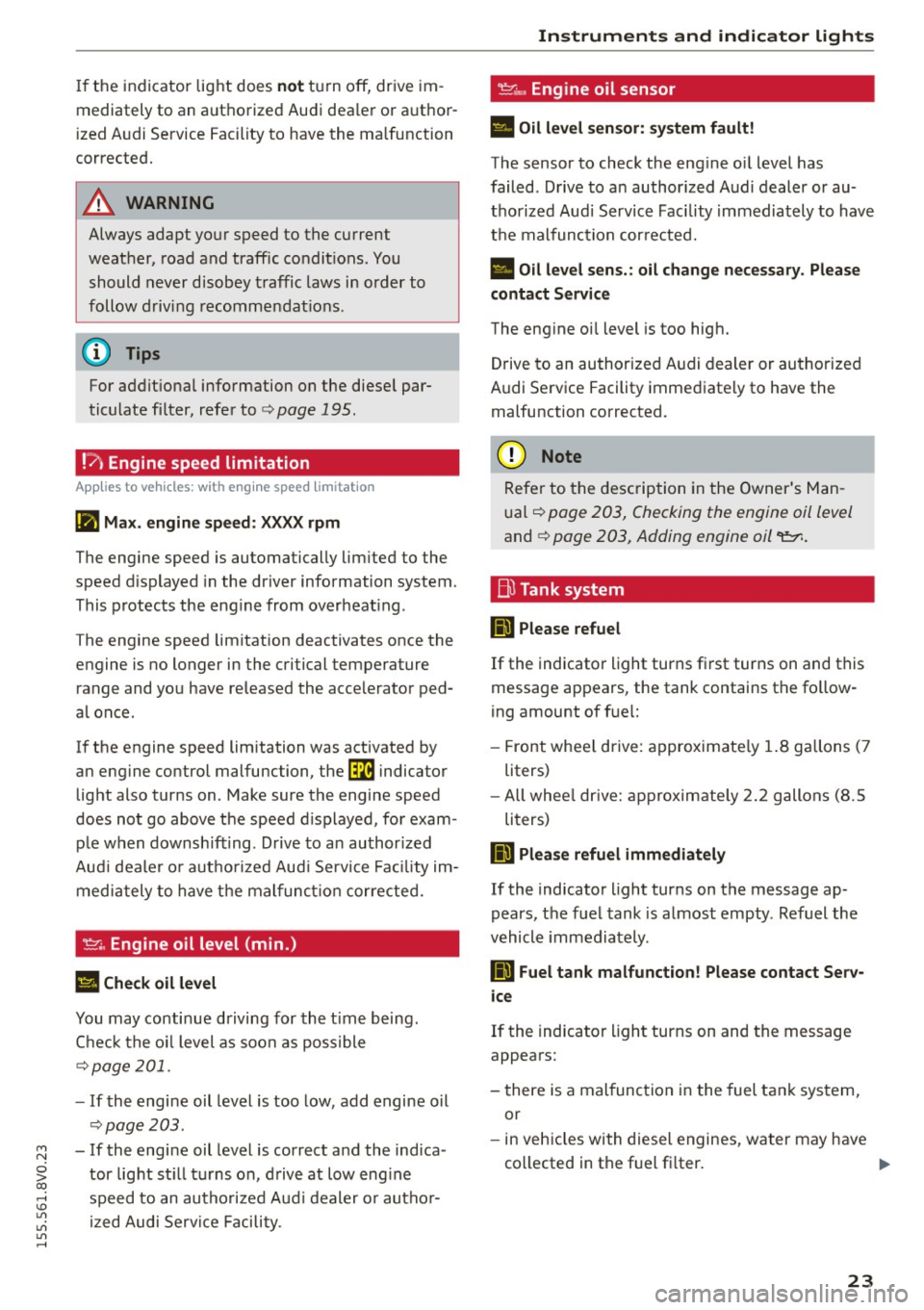
M N
0 > co ,...., \!) ..,.,
..,.,
..,., ,....,
If the indicator light does not turn off, drive im
mediately to an authorized Audi dea ler or author
ized Audi Service Facility to have the malfunction
corrected.
_& WARNING
Always adapt your speed to the current
weather, road and traffic conditions. You
should never disobey traffic laws in order to
follow driving recommendations .
@ Tips
For additional information on the diesel par
ticulate filter, refer to¢
page 195.
!7l Engine speed limitation
A pplies to vehicles: with eng ine spee d limitat ion
(II Ma x. engine speed: XXXX rpm
The engine speed is automatically limited to the
speed displayed in the driver information system.
This protects the engine from overheat ing .
The engine speed limitation deactivates once the
engine is no longer in the critical temperature range and you have released the accelerator ped
al once.
If the engine speed limitation was activated by
an engine control malfunction, the~ indicator
light also turns on . Make sure the engine speed
does not go above the speed d isplayed, for exam
ple when downshifting. Drive to an author ized
Aud i dealer or autho rized Aud i Service Facility im
mediately to have the malfunct ion corrected.
~ .. Engine oil level (min.)
l!I Check oil level
You may continue driving for the time being.
Check the oil level as soon as poss ible
¢page 201.
-If the engine oil level is too low, add engine oil
~page 203.
- If the engine oil level is correct and the indica
tor light st ill turns on, drive at low engine
speed to an authorized Audi dealer or author
ized Audi Service Facility .
Instruments and indicator lights
'I::?;."', Engine oil sensor
• Oil level sensor: system fault!
The sensor to check the engine oi l level has
failed. Drive to an author ized Audi dealer or au
thorized Audi Service Facility immediately to have
the malfunction corrected.
• Oil level sens.: oil change necessary. Please
contact Service
The engine oil level is too high.
Drive to an authorized Audi dealer or authorized
Audi Service Facility immediately to have the
malfunction corrected.
(D Note
Refer to the description in the Owner's Man
ual~
page 203, Checking the engine oil level
and¢ page 203, Adding engine oil
D Please refuel
If the indicator light turns first turns on and this
message appears , the tank contains the fol low
ing amount of fuel:
- Front wheel drive: approximate ly 1.8 gallons (7
liters)
- All whee l dr ive: approximately
2.2 gallons (8.5
liters)
Hid Please refuel immediately
If the indicator light turns on the message ap
pears, the fuel tank is almost empty. Refuel the
vehicle immediately.
D Fuel tank malfunction! Please contact Serv
ice
If the indicator light turns on and the message
appears:
- there is a malfunction in the fuel tank system,
or
- in vehicles with diesel engines, water may have
collected in the fuel fi lter.
1111>
23
Page 73 of 282

M N
0 > co ,...., \!) 1.1'1
1.1'1
1.1'1
,....,
If you anticipate w hat you need to do next and
drive economically, you can easily cut your fue l
consumption by 10-15 percent. Th is sect ion will
g ive you some tips on how you can help the envi
ronment and your pocketbook.
The consumpt ion estimates as published by
ENVIRONMENTAL PROTECTION AGENCY (EPA)
and Transport Canada may not correspond to
your actual consumption on the road, which
w ill vary depend ing upon vehicle load and
speed, road and weather conditions, trip
length, e tc.
Drive smoothly and keep a lookout ahead
Vehicles use the most fuel when they are acceler
ating.
.. Avoid unnecessary accelerating and braking.
Vehicles use the most fuel when they are acceler
ating. If you anticipate what is going to happen next, you will need to brake less and, thus, accel
erate less. Let the vehicle coast whenever possi b le -for example when you see that the next traf
fic light is red.
Avoid full throttle
Driving at moderate speeds saves fuel and im
proves your mileage .
.. Try and keep well be low your car's max imum
speed .
Accelerating gently reduces fuel consumpt ion,
engine wear, and does not d isturb the env iron
ment .
Fue l consumption, exha ust emissions and eng ine
noise increase disproportionately at high speeds.
If you drive at approx imately t hree quarters of
top speed, fuel consumpt ion w ill be reduced by
one half . Never dr ive faste r than the posted
speed limit a nd weather conditions perm it.
Dri ving
Reducing unnecessary idling
Even when your car is just idling it burns up fuel .
.. Shut the eng ine off when you are not driving
the vehicle .
.. Do not warm up the vehicle by lett ing the en-
gine run at idle.
It is efficient to switch off the engine when stop
ped at ra ilroad crossings and long red lights.
Turning the engine off for just 30-40 seconds
saves more fuel than is b urned by starti ng the
engine aga in .
It takes a long t ime for the engine to warm up
fully when it is ru nning at idle. However, wear
and noxious emissions are espec ia lly hig h when
t h e engine is warming up. So you should d rive
away as soon as you sta rt the eng ine and avoid
run ning at high rpms w hile the eng ine is s till
warmi ng up .
@ Note
Do no t leave eng ine idl ing una ttended afte r
s ta rtin g.
If war ning lig hts s hou ld come on to
i ndica te imprope r operat ion, they would go
u nheede d. Extended idling also produces
heat, which could result in overheat ing or oth
er damage to the ve hicle or other property.
Regular maintenance
A badly tuned engine unnecessarily wastes a lot
of fuel.
.. Have your ve hicle serviced at reg ular in tervals.
B y havi ng your ve hicle regu la rly se rv iced by an
Audi dealer he lps to ensu re that it ru ns p rope rly
and economically. The condi tion of your veh icle
not only affects its sa fety and ability to ho ld i ts
val ue, it also affects
fuel consumption.
Check your oil each time you fill your tank.
The amou nt of oi l used is re lated to engine load
and speed.
It is normal for the oil consumption of a new en
gine to reach its lowest value after a certai n m ile-
age has been dr iven. ...,
71
Page 128 of 282
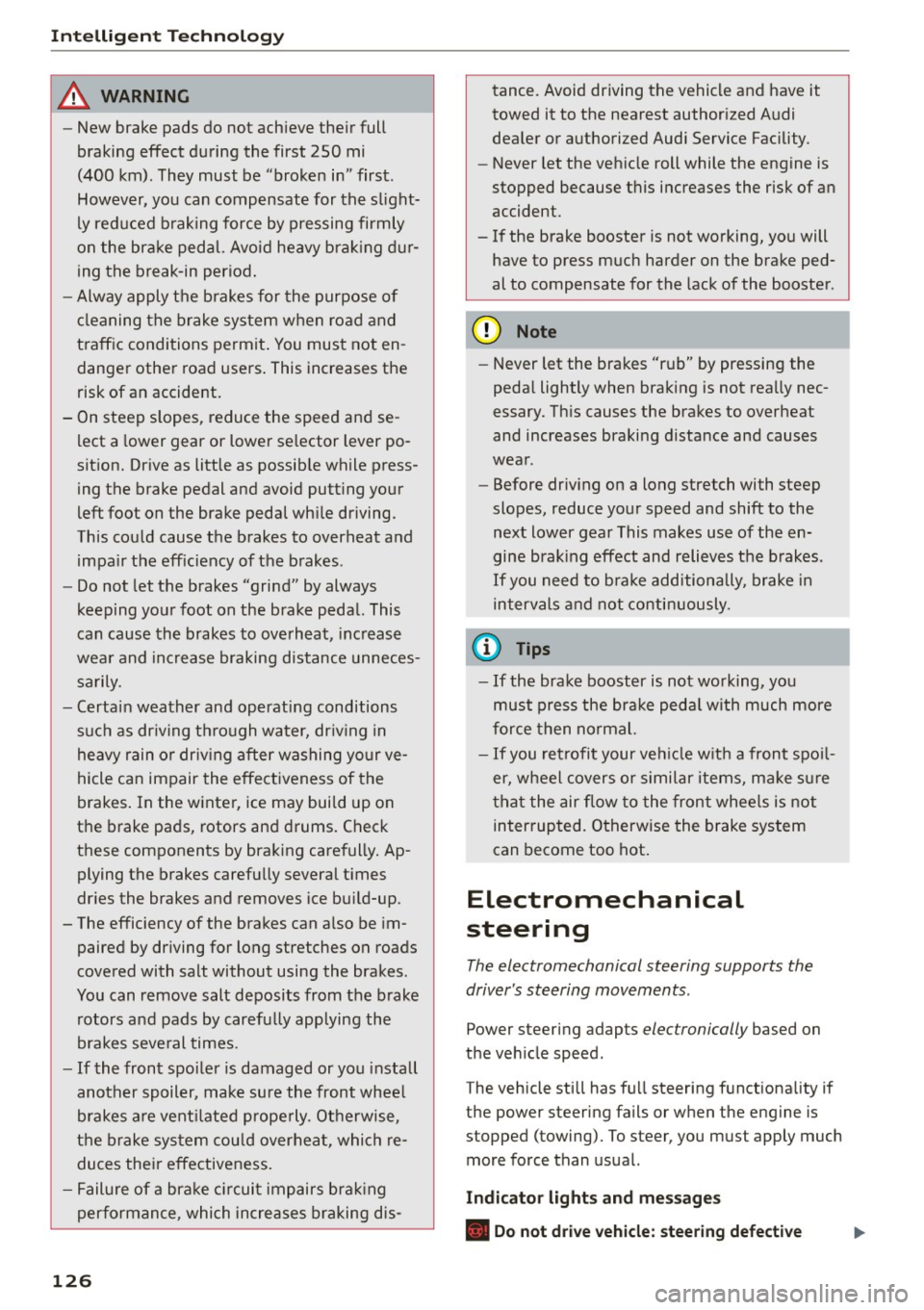
Intelligent Technology
& WARNING
-New brake pads do not achieve their full
braking effect during the first 250 mi
(400 km). They must be "broken in" first .
However, you can compensate for the slight·
ly reduced braking force by pressing firmly
on the brake pedal. Avoid heavy braking dur·
ing the break-in period.
- Alway apply the brakes for the purpose of
cleaning the brake system when road and
traffic conditions permit. You must not en·
danger other road users. This increases the
risk of an accident.
- On steep slopes , reduce the speed and se
lect a lower gear or lower selector lever po·
sition. Drive as little as possible while press· ing the brake pedal and avoid putting your
left foot on the brake pedal while driving.
This could cause the brakes to overheat and impair the efficiency of the brakes .
- Do not let the brakes "grind" by always
keeping your foot on the brake pedal. This
can cause the brakes to overheat, increase
wear and increase braking distance unneces·
sarily.
- Certain weather and operating conditions
such as driving through water, driving in
heavy rain or driving after washing your
ve·
hide can impair the effectiveness of the
brakes. In the winter, ice may build up on
the brake pads, rotors and drums. Check
these components by braking carefully. Ap·
plying the brakes carefully several times
dries the brakes and removes ice build-up .
- The efficiency of the brakes can also be im·
paired by driving for long stretches on roads
covered with salt without using the brakes.
You can
remove salt deposits from the brake
rotors and pads by carefully applying the
brakes several times.
- If the front spoiler is damaged or you install
another spoiler, make sure the front wheel
brakes are ventilated properly . Otherwise,
the brake system could overheat, which re·
duces their effectiveness.
- Failure of a brake circuit impairs braking
performance, which increases braking dis·
126
tance. Avoid driving the vehicle and have it
towed it to the nearest authorized Audi
dealer or authorized Audi Service Facility .
- Never let the vehicle roll while the engine is
stopped because this increases the risk of an
accident .
-If the brake booster is not working, you will
have to press much harder on the brake ped·
al to compensate for the lack of the booster .
(D Note
-Never let the brakes "rub" by pressing the
pedal lightly when braking is not really nee·
essary. This causes the brakes to overheat
and increases braking distance and causes
wear .
- Before driving on a long stretch with steep
slopes, reduce your speed and shift to the
next lower gear This makes use of the en·
gine braking effect and relieves the brakes .
If you need to brake additionally, brake in
intervals and not continuously.
(D Tips
-If the brake booster is not working, you
must press the brake pedal with much more
force then normal.
- If you retrofit your vehicle with a front spoil·
er, wheel covers or similar items, make sure
that the air flow to the front wheels is not
interrupted. Otherwise the brake system
can become too hot.
Electromechanical
steering
The electromechanical steering supports the
driver's steering movements .
Power steering adapts electronically based on
the vehicle speed.
T he vehicle still has full steering functionality if
the power steering fails or when the engine is
stopped (towing). To steer, you must apply much
more force than usual.
Indicator lights and messages
• Do not drive vehicle: steering defective
Page 193 of 282
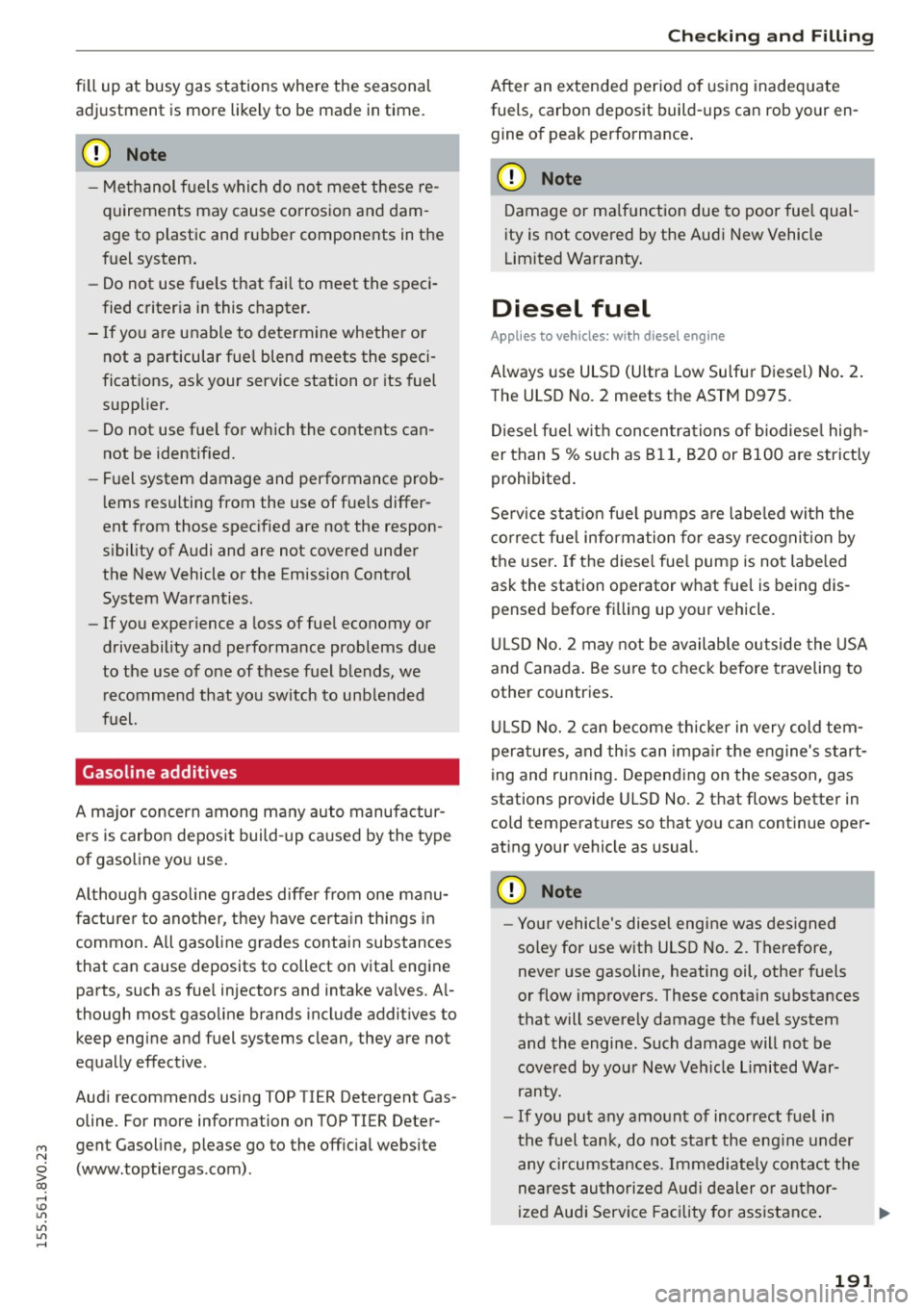
fill up at busy gas stations where the seasonal
adjustment is more likely to be made in time.
(D Note
- Methanol f uels which do not meet these re
quirements may cause corrosion and dam
age to plastic and rubber components in the
fuel system.
- Do not use fue ls that fail to meet the speci
fied criteria in this chapter.
- If you are unable to determine whethe r o r
not a particular fue l blend meets the speci
fications, ask your service station or its fuel
supplier.
- Do not use fuel for which the contents can
not be identified.
- Fuel system damage and performance prob
lems resulting from the use of fue ls differ
ent from those specified are not the respon
s ibility of Audi and are not covered under
the New Vehicle or the Emission Control
System Warranties.
- If you experience a loss of fuel economy or
driveability and performance problems due
to the use of one of these fuel b lends, we
recommend that you sw itch to unb lended
fuel.
Gasoline additives
A ma jor concern among many auto manufactur
ers is carbon deposit build-up caused by the type
of gasoline you use.
Although gasol ine grades differ from one manu
facture r to another, they have certa in things in
common . All gasoline grades contain substances
that can cause deposits to collect on vita l engine
parts, such as fue l injectors and intake valves. A l
though most gasoline brands include additives to
keep engine and fuel systems clean, they are not
equally effective .
Audi recommends using TOP TIER Detergent Gas
oline. For more information on TOP TIER Deter-
"' gent Gasoline, please go to the off icial webs ite
N
~ (www .toptiergas.com).
co ,...., \!) 1.1'1
1.1'1
1.1'1
,....,
Checking and Fillin g
After an extended period o f using inadeq uate
fuels, carbon deposit build-ups can rob your en gine of peak performance .
(D Note
Damage or malf u nction due to poor fuel qual
ity is not cove red by the Audi New Vehicle
Limited Wa rranty.
Diesel fuel
Applies to vehicles: with diesel engine
Always use ULSD (Ultra Low Su lfur Diesel) No. 2 .
The ULSD No. 2 meets the ASTM 0975.
Diesel fuel w ith concen tra tions of biodiese l hig h
er than 5
% such as Bl 1, B20 or 8100 are strictly
prohibited .
Se rv ice stat io n fue l pumps a re labe led with the
correct fue l information for easy recognit ion by
the user .
If the diese l fue l pump is not labe led
ask the station operator w hat fue l is being dis
pensed before fi lling up your vehicle.
UL SD No. 2 may not be available outside the USA
and Canada . Be sure to check before traveling to
other countr ies .
UL SD No. 2 can become thicke r in very cold tem
pera tures, and th is can impa ir t he engine's start
ing and running. Depending on the season, gas
stations provide ULSD No . 2 that flows better in
cold temperatures so that you can continue oper
at ing your vehicle as usual.
@ Note
- Yo ur vehicle's diesel engine was designed
soley for use with ULSD No. 2. Therefore,
never use gasoline, heating oil, other fuels
or flow improvers. These conta in substances
that will severe ly damage the fuel system
and the engine . Such damage will not be
covered by you r New Veh icle Limited War
ranty.
- If you put any amount of incorrect fuel i n
the fuel tank, do not start the eng ine under
any circumstances. Immediate ly co ntact t he
nearest authori zed Aud i dealer or autho r
ized Aud i Service Fac ility for assistance .
191
Page 196 of 282
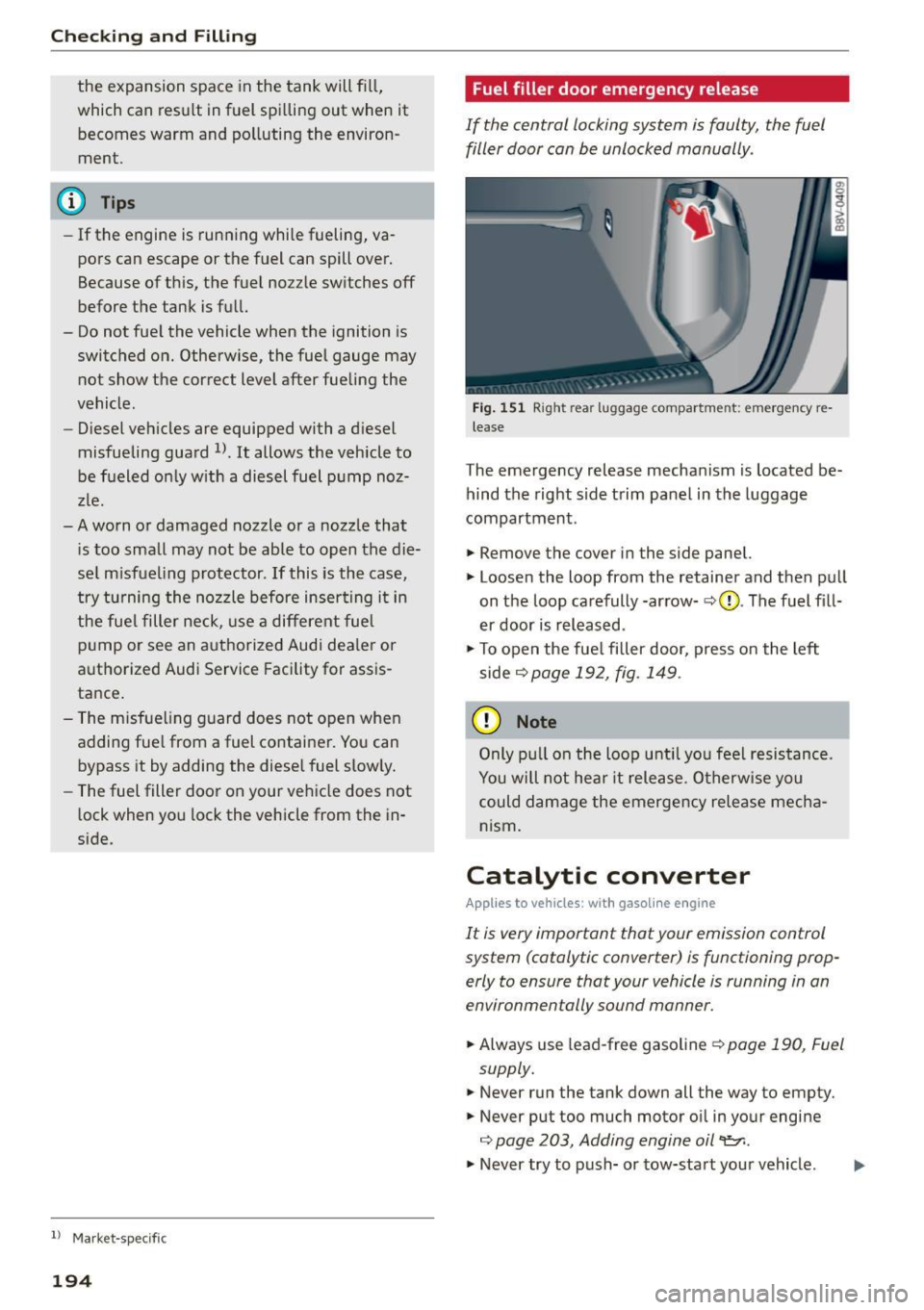
Checking and Fill in g
the expansion space in the tank will fi ll,
which can result in fuel spilling out when it
becomes warm and polluting the environ
ment.
(D Tips
- If
the engine is running while fueling, va
pors can escape or the fuel can spill over.
Because of th is, the fuel nozz le switches off
before th e tank is full.
- Do not fue l the vehicle when the ignition is
switc hed on. Otherwise, the fuel gauge may
not show the correct level after fueling the
vehicle.
- Diesel vehicles are equipped with a diesel
misfueling guard
l). It allows the vehicle to
be fueled on ly w ith a diesel fuel p ump noz
zle .
- A worn o r damaged nozzle or a nozz le that
i s too sma ll may not be able to open the die
se l m isfue ling protector. If this is the case,
try turning the no zzle before inser ting it in
the fue l filler neck, use a different fuel
p ump or see an a uthorized Audi dea le r or
a uthorized Audi Service Facility for assis
tance .
- The misfueling guard does not o pen whe n
adding fue l from a fuel contai ne r. Yo u can
bypass it by adding the diese l fuel s low ly .
- The fuel filler door on your vehicle does not
l ock when you lock the vehicle from the in
side.
l l Market -spec ifi c
194
Fuel filler door emergency release
If the central locking system is faulty, the fuel
filler door can be unlocked manually .
Fig. 15 1 Rig ht rear luggage compartme nt: emergency re
lease
The emergency release mechanism is located be
hind the right side trim panel in the luggage
compartment.
.,. Remove the cover in the side panel.
.,. Loosen the loop from the retainer and then pull
on the loop ca refully-ar row-
c::> 0 . The fuel fill
er door is released .
.,. To open the fue l filler door, press o n the left
side
opage 192, fig. 149 .
(D Note
Only pull on t he loop u ntil yo u feel resistance.
You will not he ar it release. O therwise you
could damage the emergency rele ase mecha
nism.
Catalytic converter
App lies to vehicles: with gasoline e ngine
It is very important that your emission control
system (catalytic converter) is functioning prop
erly to ensure that your vehicle is running in an
environmentally sound manner .
.,. Always use lead-free gasoline c::> page 190, Fuel
supply .
.,. Never run the tank down all the way to empty .
.,. Never put too much motor o il in yo ur engine
o page 203, Adding engine oil 'l:::11 .
.,. Never try to push- or tow-sta rt you r vehicle .
Page 197 of 282
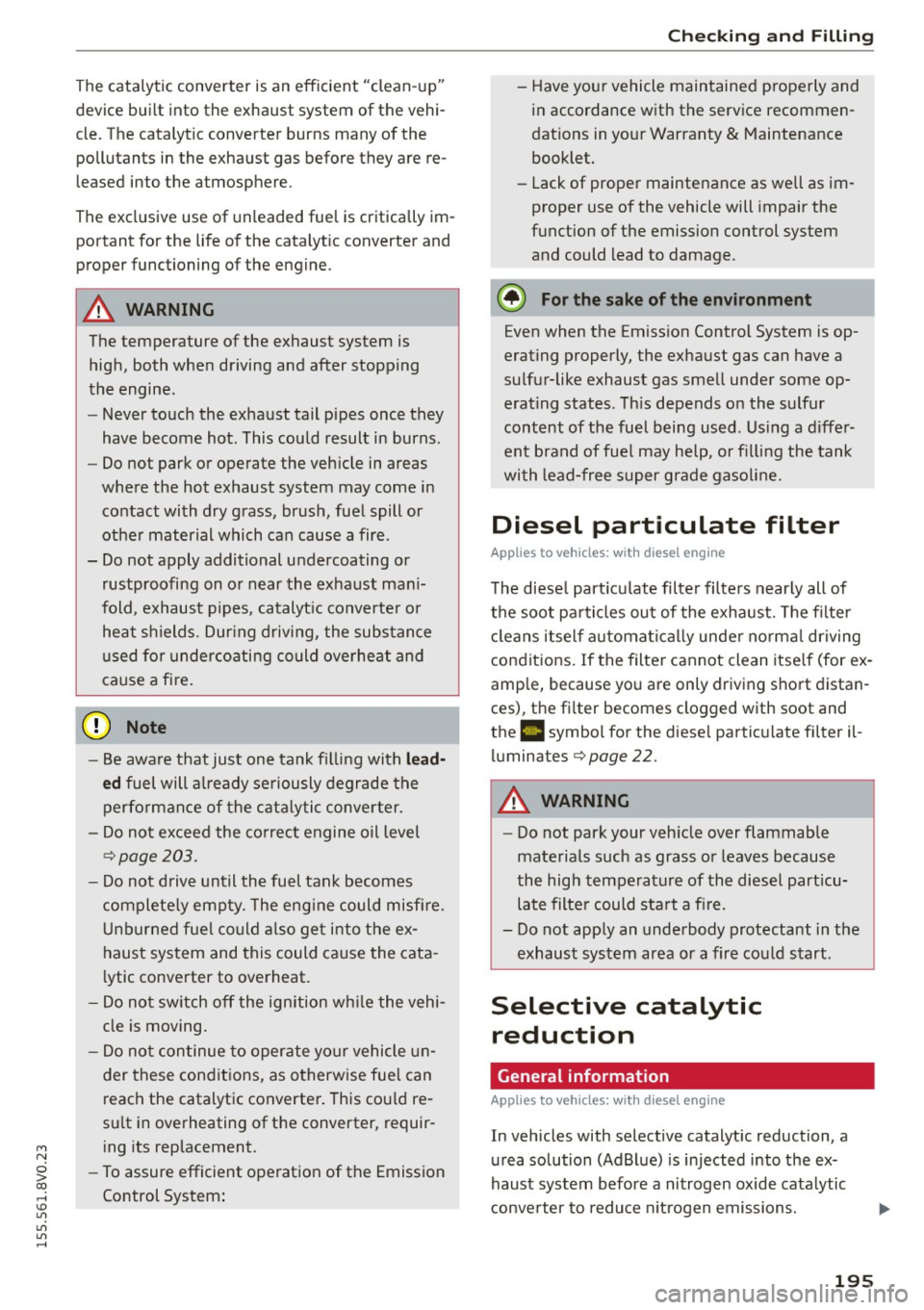
M N
0 > co ,...., \!) ..,.,
..,.,
..,., ,....,
The catalytic conve rter is an efficient "clean -up"
device bui lt into the exhaust system of the vehi
cle. The catalytic converter burns many of the
pollutants in the exhaust gas before they are re
leased into the atmosphere.
The exclusive use of unleaded fue l is critically im
portant for the life of the catalytic converter and
proper functioning of the engine .
A WARNING
The temperature of the exhaust system is
high, both when driving and after stopping
the engine.
- Never touch the exhaust tail pipes once they
have become hot. This could result in burns.
- Do not park or operate the vehicle in areas
where the hot exhaust system may come in contact with dry grass, brush, fue l spill or
other material which can cause a fire .
- Do not apply additional undercoating or
rustproofing on o r near the exha ust man i
fold, exhaust pipes, catalyt ic converte r or
heat s hields. Dur ing driv ing, the subs tance
u5ed for undercoating could overheat and
cause a fire .
(D Note
-Be awa re that just one tank f illing wit h lead
ed
f uel will a lready se riously degrade the
performance of the c ata lytic conver ter.
- Do not exceed the co rrect engine oil leve l
9page203.
-Do not d rive until the fuel tank becomes
complete ly empty. The eng ine could misfi re.
U nburned f uel co uld also ge t in to the e x
haust system and this could ca use the cata
l ytic converter to overheat.
- Do no t sw itch off the ignition wh ile the vehi
cle is moving.
- Do not con tinue to oper ate yo ur vehicle un
der these cond itions, as o therwise fue l can
r each the catalytic converte r. This cou ld re
su lt in overheating of the converter, requir
i ng its replacement.
- To assure efficient ope ration of the Emission
Control System:
Checking and Fillin g
- Have your vehicle maintained properly and
in accordance with the serv ice recommen
dat ions in yo ur Warranty
& Maintenance
booklet.
- Lack of prope r maintenance as we ll as im
p roper use of the vehicle will impair the
f u nction of the emission control system
and could lead to damage.
@ For the sake of the environment
Even when the Emission Control System is op
erating properly, the exha ust gas can have a
su lfur-like exhaust gas sme ll under some op
erating states. Th is depends on the s ulfur
content of the fuel b eing used. Us ing a diffe r
ent bra nd of fue l may he lp, or fi lling the tank
wi th lead-free su per grade gaso line.
Diesel particulate filter
App lies to vehicles: wit h diese l eng ine
T he diese l part icu late filter filters nearly all of
the soot pa rticles ou t of the exha ust. The filter
cl ea ns itself a utoma tic all y unde r no rm al driving
con dit ions. If the filte r cannot clean itse lf (for ex
amp le, because yo u are only driving sho rt distan
ces), th e fi lter becomes clogged with soot and
the
II symbol for the diese l partic ulate filter il
l uminates
9page 22.
A WARNING
-Do not park your veh icle over flammable
materials such as grass or leaves because
the high temperature of the diesel part icu
la te filte r could sta rt a fi re.
-
- Do not app ly an underbody protectant in the
exhaust system area or a fire cou ld start.
Selective catalytic
reduction
General information
App lies to vehicles: wit h diese l eng ine
In veh icles with selective catalytic reduction, a
u rea solution (AdBlue) is injected into the ex
haust system before a nitrogen oxide cata lytic
conve rter to redu ce nitrogen emissions.
195
Page 201 of 282
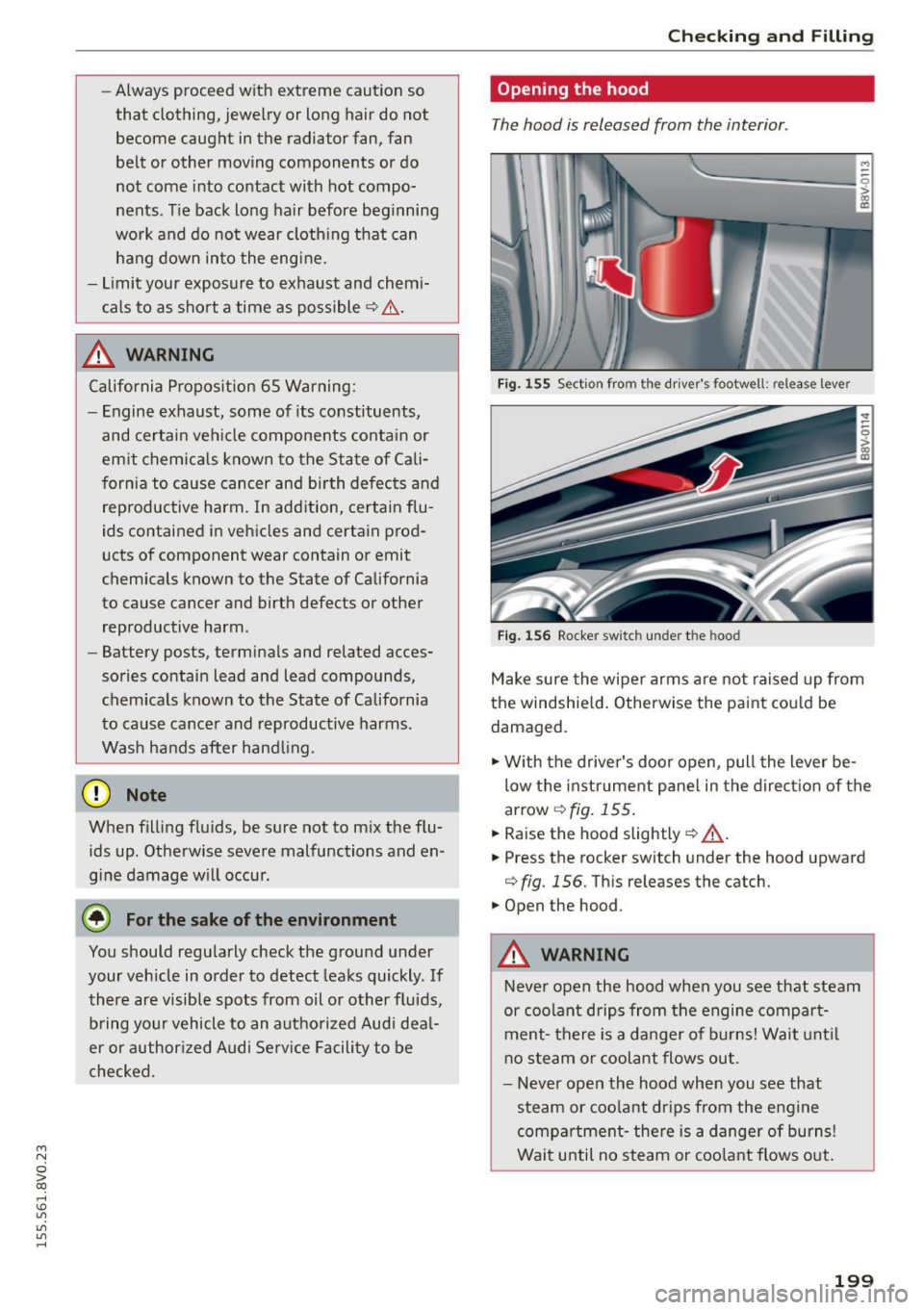
....,
N
0 > co
rl I.O
"'
"'
"'
rl
-Always proceed with extreme caution so
that clothing, jewelry or long hair do not
become caught in the radia tor fan, fan
belt or other moving components or do not come into contact with hot compo
nents . T ie back long hair before beg inning
work and do no t wear cloth ing that can
hang down into the eng ine.
- limit your exposure to exhaust and chemi
cals to as short a time as possible
q ,& .
..&, WARNING
California Propos ition 65 Warning:
- Engine exhaust, some of its constituents,
and certai n veh icle components conta in or
em it chemicals known to the State of Cali
forn ia to cause cancer and birth defec ts and
reproductive harm. In addition, certai n flu
ids contained in vehicles and certain prod
ucts of component wear contain or emit
chemicals known to the State of California
t o cause cancer and birth defects or other
reproductive harm .
- Battery posts , terminals and related acces
sories contain lead and lead compounds,
chem icals known to the State of California
to cause cancer and reproductive harms .
Wash hands after hand ling.
(D Note
When filli ng flu ids, be sure not to m ix the flu
ids up . Otherwise seve re malfunctions and en
gine damage w ill occur .
@ For the sake of the environment
You should regu larly check the grou nd under
your veh icle in order to detect leaks quickly . If
there are visible spots from oil or other f luids,
b ring yo ur vehicle to an autho rized Aud i dea l
er or authori zed Audi Se rv ice F acili ty to be
checked.
Ch eck in g and Fillin g
Opening the hood
The hood is released from the in terior .
Fig . 155 Se ctio n from t he dr iver' s footwe ll: re le a se le ve r
Fig . 156 Ro cke r swit c h un der t he hoo d
Make sure the wiper arms a re not raised up from
the windsh ie ld . Oth erwise the paint cou ld be
damaged.
.,. W ith the driver's door open, pull the lever be
low the instr ument pane l in the d irect ion of the
arrow
<=> fig. 155.
.,. Raise the hood slightly r:!> ff::.. .
.,. Press the rocker switch unde r the hood upward
q fig. 156 . This re leases the catch .
.,. Open the hood .
..&, WARNING
-=
Never open the hood when you see that steam
or coolant drips from the engine compart
ment- there is a da nger of bu rns! Wait unt il
n o steam or coolant flows out .
- Never open the hood when you see that
s team or coo lant dr ips from the e ngine
comp artment- the re is a dange r of burns !
Wait until no steam or coo lant flows o ut .
199